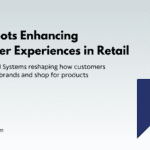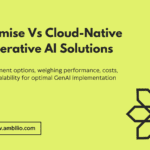In the rapidly evolving world of artificial intelligence, generative AI stands out as a transformative technology with immense potential across industries. However, the journey from conceptualization to full-scale deployment of generative AI systems is fraught with complex financial considerations. This article delves into the multifaceted costs associated with piloting and deploying Generative AI, and provides a framework for evaluating these expenses effectively.
Understanding the Cost Components
Understanding the cost components of deploying generative AI is crucial for effective budgeting and strategic planning. From infrastructure and software to data acquisition and human expertise, each element contributes significantly to the overall financial landscape of AI implementation. Let’s delve into these in details
Infrastructure Costs
At the heart of any generative AI system lies its computational infrastructure. This typically involves high-performance computing resources such as Graphics Processing Units (GPUs) or Tensor Processing Units (TPUs). These specialized hardware components are essential for the intensive mathematical operations that power AI models. The costs here can be substantial, with high-end GPUs often priced in the thousands of dollars each.
Cloud services have become increasingly popular for AI deployments due to their scalability and flexibility. Major providers like Amazon Web Services (AWS), Google Cloud Platform (GCP), and Microsoft Azure offer AI-optimized instances, but these come at a premium. Storage costs for the vast amounts of data required for training and operating generative AI models can also add up quickly.
Networking infrastructure is another critical component, especially for distributed AI systems or those requiring real-time data processing. High-speed, low-latency networks are often necessary, which can incur significant costs in both hardware and ongoing bandwidth charges.
Software and Licensing
While many AI frameworks and libraries are open-source, enterprise-grade AI platforms often require costly licenses. These platforms provide essential features like model versioning, experiment tracking, and deployment management. Costs can range from thousands to hundreds of thousands of dollars annually, depending on the scale and sophistication of the platform.
Development tools, integrated development environments (IDEs), and specialized AI debugging tools also contribute to the software cost stack. While some are free or have freemium models, enterprise versions with advanced features and support can be expensive.
Data Costs
Data is the lifeblood of generative AI, and acquiring or generating high-quality, relevant data sets can be one of the most significant expenses. This might involve purchasing data from third-party providers, setting up data collection systems, or even creating synthetic data.
Data preparation is a labor-intensive process that often requires specialized tools and expertise. This includes cleaning the data, normalizing it, and ensuring it’s properly labeled or annotated. The costs here are primarily in human resources and specialized software tools.
Human Resources
The human element in generative AI deployment is often the largest ongoing cost. AI and machine learning engineers command high salaries due to the specialized nature of their skills. As of 2024, experienced AI engineers can easily command salaries exceeding $150,000 per year in many markets.
Data scientists, who are crucial for developing and refining AI models, are similarly in high demand and command premium salaries. Project managers with AI expertise are essential for keeping complex AI initiatives on track and can also command significant compensation.
Domain experts are often necessary to provide context and ensure that the AI models are aligned with specific industry needs. Their involvement can be costly but is crucial for developing effective, domain-specific AI solutions.
Training and Fine-tuning
The process of training large generative AI models is computationally intensive and can incur substantial costs. For example, training a large language model like GPT-3.5 was estimated to cost millions of dollars in computational resources alone.
Fine-tuning these models for specific applications adds another layer of expense. This process often requires multiple iterations, each consuming significant computational resources and expert time.
Integration and Deployment: Integrating generative AI into existing business processes and IT infrastructures can be a complex and costly endeavor. This might involve reengineering existing systems, developing new interfaces, or creating entirely new workflows to accommodate AI-driven processes.
Scaling AI systems from pilot projects to full production environments often reveals hidden costs. This can include the need for more robust monitoring systems, increased security measures, and enhanced data pipelines to handle larger volumes of data and requests.
Ongoing Operational Costs
Once deployed, generative AI systems require constant monitoring and maintenance. This includes regular updates to the models, fine-tuning based on new data, and addressing any biases or errors that emerge over time.
The energy consumption of AI systems, particularly large generative models, can be substantial. As organizations become more conscious of their carbon footprint, the costs associated with powering these systems – both financial and environmental – are increasingly important considerations.
Compliance and Security
In many industries, AI systems must comply with strict regulatory requirements. This can necessitate ongoing audits, documentation processes, and potentially the development of explainable AI systems, all of which add to the overall cost.
Cybersecurity is paramount when dealing with the sensitive data often used in deploying generative AI applications. Implementing robust security measures, including encryption, access controls, and threat detection systems, adds another layer of expense.
Evaluating the Costs
Evaluating the costs of deploying generative AI requires a multifaceted approach. This includes conducting thorough needs assessments, performing TCO analyses, benchmarking against industry standards, and considering both tangible expenses and potential long-term benefits of AI implementation. Let’s delve into these in details
Conducting a Thorough Needs Assessment
Before embarking on any generative AI project, organizations must clearly define their objectives and use cases. This involves identifying specific problems that AI can address and quantifying the potential value of these solutions. A well-defined scope can prevent costly overruns and ensure that resources are allocated effectively.
Total Cost of Ownership (TCO) Analysis
A comprehensive TCO analysis is crucial for understanding the true cost of generative AI implementation. This should include not just the upfront costs of hardware and software, but also ongoing expenses like maintenance, upgrades, and operational costs. A multi-year projection is essential, as many of the benefits of AI may only be realized over an extended period.
Benchmarking Against Industry Standards
Understanding how costs compare to industry norms can provide valuable context. This might involve researching case studies, attending industry conferences, or engaging with AI vendors and consultants to gather benchmarking data.
Leveraging Cost Estimation Tools
Many cloud providers offer detailed pricing calculators that can help estimate the costs of running AI workloads on their platforms. Additionally, specialized AI cost estimation tools are emerging that can provide more nuanced projections based on specific AI architectures and use cases.
Pilot Projects and Scaling Considerations
Starting with small-scale pilot projects can provide valuable insights into real-world costs and challenges. These pilots should be designed to be representative of the full-scale deployment but manageable in scope. The data gathered from these pilots can then be used to extrapolate costs for a full deployment more accurately.
Opportunity Cost and ROI Analysis
While the direct costs of generative AI can be substantial, it’s equally important to consider the opportunity costs of not implementing these technologies. This involves assessing potential efficiency gains, new revenue streams, or competitive advantages that AI could unlock. A thorough return on investment (ROI) analysis should balance the costs against these potential benefits.
Factoring in Hidden Costs
Many organizations underestimate the hidden costs associated with AI deployment. These can include the costs of change management as employees adapt to new AI-driven processes, potential disruptions or downtime during implementation, and ongoing training needs for staff working with AI systems.
Continuous Reassessment
The field of AI is evolving rapidly, with new technologies and approaches emerging regularly. As such, cost projections should be revisited frequently. What might be a cost-prohibitive approach today could become economically viable in the near future due to technological advancements or changes in the market landscape.
Final Words
While the costs of piloting and deploying generative AI can be substantial, a thorough understanding and careful evaluation of these expenses can lead to more successful and economically viable implementations. By considering the full spectrum of costs – from infrastructure and data to human resources and ongoing operations – organizations can make informed decisions about their AI investments. As generative AI continues to mature, those who can effectively navigate its financial landscape will be best positioned to reap its transformative benefits.



